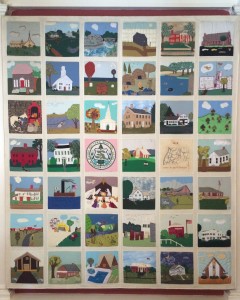
The most vivid memory of my first visit to The Wood Memorial Library & Museum is of the 103 ½-inch-x-89-inch quilt that caught my eye when I walked in the main entrance and glanced toward the staircase that leads to the second floor.
The South Windsor Bicentennial Quilt was unveiled at the town 1976 Spring Fair by members of The Wapping Community Church Women’s (WCCW) group. In celebration of our country’s 200th birthday, the WCCW designed and created a quilt depicting the history of South Windsor, Connecticut. The quilt contains forty-two squares, and each details a scene from the historic community. Squares include: Foster Farm, Podunk Mill, Wood Memorial Library, Bossen’s General Store, and the South Windsor Post Office. Each unique, beautiful square harmonizes with the quilt pattern as a whole, much like each community institution works together to form the town.
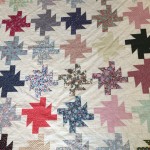
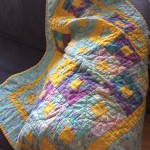
I have always had an affinity for quilts, which was inspired by my grandmother, who made quilts for her nine children and their families. She sewed and embroidered at least 100 quilts of various sizes throughout her lifetime. I was lucky enough to receive a quilt from her when I was in college and another when I got married. My eyes always sting with excitement when I look at her quilts. The colors and the patterns are vibrant and geometrical. For me, quilts are part of my family, a Davis tradition that my Aunt Barb is continuing.
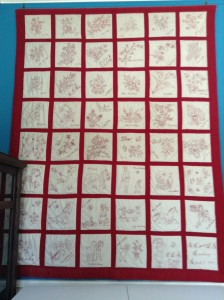
At the Wood Memorial Library & Museum, I met Claire Lobdell, Archivist and Museum Educator. When I told her about my initial interest in the Bicentennial Quilt, she informed me of the other quilts in their collection. She took me to the second floor, where the Long Hill Quilt hangs. The Long Hill Quilt is a friendship quilt, a type of quilt popular in the mid to late 1800s. Originally, friendship quilts were made when friends and family moved away from their community; those left behind would sew together scraps of their clothing as remembrances. As friendship quilts evolved, sewing circles created squares that they would piece together to make quilts for members of the community who were getting married, having children, or moving away1.
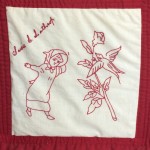
In the 1890s, members of the Long Hill section of South Windsor started a friendship quilt. Over fifty people were involved in making squares for the quilt. But it wasn’t until 1977 that Susie Lathrop Briggs, at age ninety-seven, one of the members of the group that began the Long Hill project, found the stack of embroidered squares in her attic; they had never been sewn together. Briggs donated the squares to the Wood Museum & Library, and The Wood Library Quilters took the fifty-six unbleached muslin penny squares, each embroidered using “turkey” (red color) floss, and took on the project of piecing together a quilt1. The Long Hill Quilt is now on permanent display in the museum.
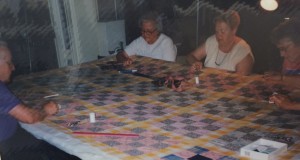
Lobdell told me about the group of quilters who belonged to the Friends of Wood Memorial Library. The group, no longer consistently active, was a big part of the museum for a long period of time. They were commissioned mainly by local community members to finish quilts for modest fees that were donated to the museum. Lobdell showed me the scrapbooks that contained photographs of members of the quilting group working on various quilts over the years.
Finally, Lobdell took me down to the lower level of the museum, and she pulled from the archives a crazy quilt donated to the museum in 1894. I was fascinated by the cluster of different patterns in the quilt, as well as the various materials used across the different squares. I researched crazy quilts to understand the skew from the traditional patterned design. The Aesthetic Movement in America, influenced by the Centennial Exposition in Philadelphia and the first exposure of Japanese art and style, affected the quilting tradition. Harper’s Bazaar, in 1882, stated, “We have quite discarded in our modern quilts the regular geometric design once so popular… Now we are very daring. We go boldly on without any apparent design at all2″. This quilt was clearly made during this time.
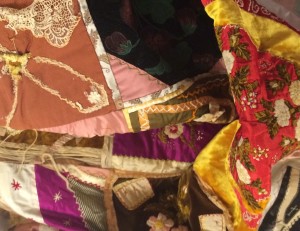
Lobdell told me the museum’s quilting group hasn’t been active for several months. She mentioned that a number of the women were getting older, and a younger generation had not taken over as of yet. It made me think about my grandmother’s quilts. I treasure the quilt she gave me because it symbolizes family and tradition; I will pass on this quilt to my children. I was suddenly sad. Would we have these cherished gifts in the future? I asked Lobdell if she thought the art of quilting would remain a piece of current culture. She was optimistic: “I have friends who quilt. People are certainly still quilting. Perhaps it just isn’t as collective as it used to be.”
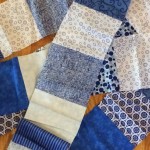
The art and tradition of quilting wrap us in the story of our community, ties us to our families and friends or maybe just keeps us warm. I’m learning what it means to me as I start my first quilt for my son.
References
1. Klein, Jean H. “The Long Hill Quilt.” Booklet 2007.15.001, The Wood Memorial Library & Museum, 1998.
2. Kiracofe, Roderick and Johnson, Mary Elizabeth. The American Quilt: A History of Cloth and Comfort 1750-1950. New York: Clarkson N. Potter, Inc., 1993.
Melissa Gordon
Advisory Board Member
